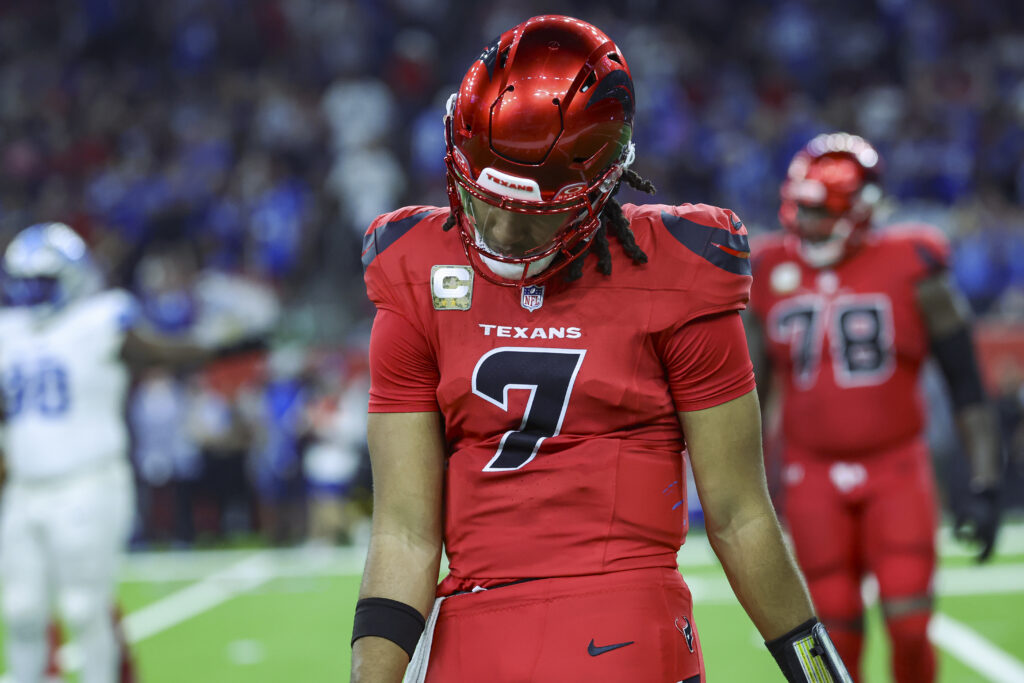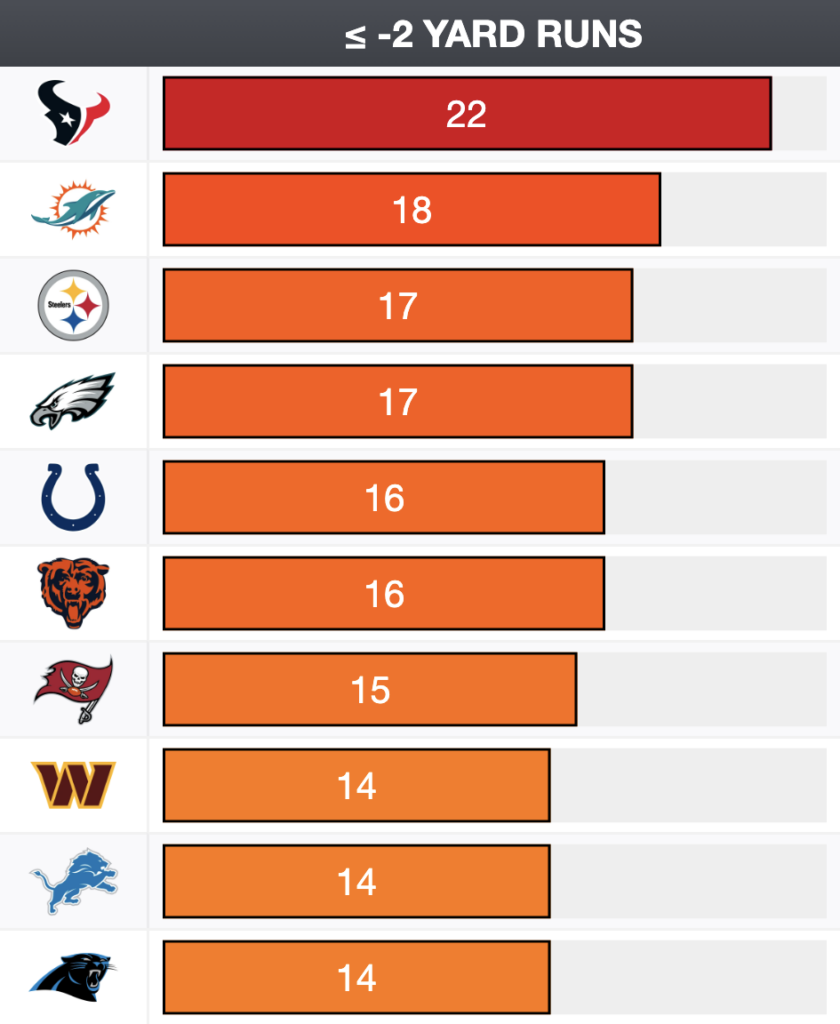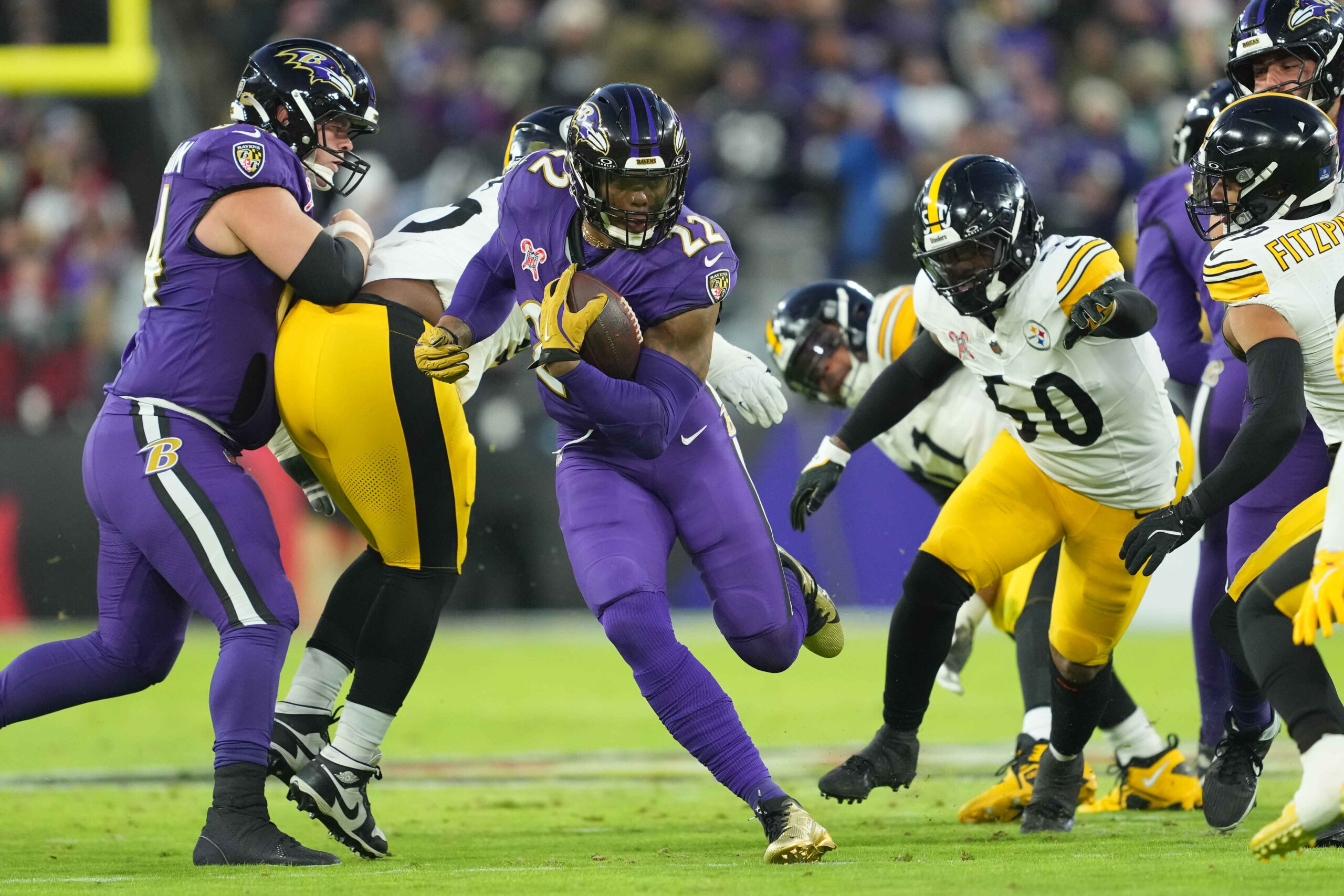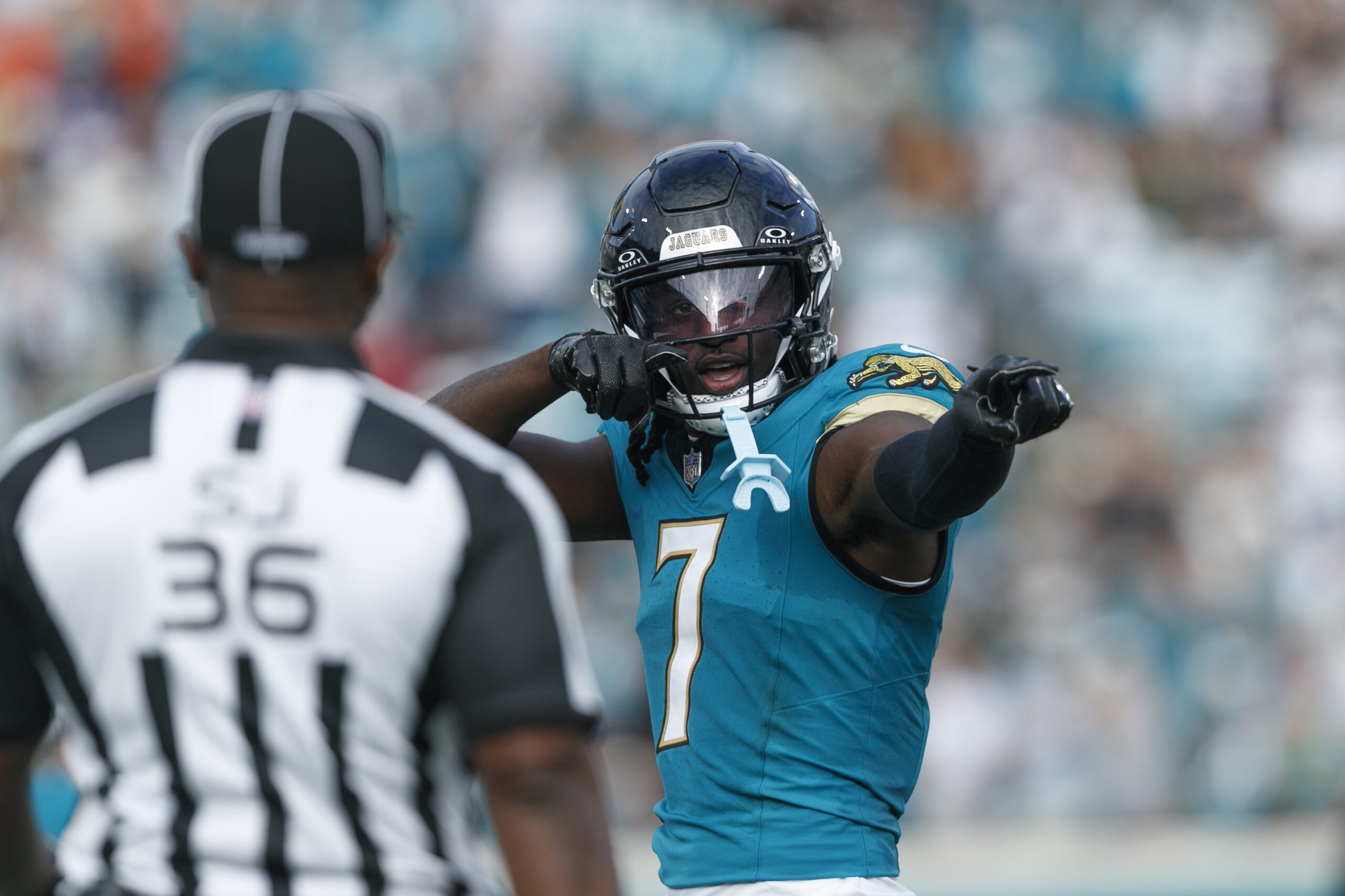NFL Analysis
11/14/24
14 min read
Is It Time to Panic About Texans Offense, C.J. Stroud?

The Houston Texans’ offense was one of the biggest surprises of 2023, as C.J. Stroud won Rookie of the Year, Nico Collins emerged as an alpha wide receiver, and Bobby Slowik capped off the season with five head coaching interviews.
In April, they added Stefon Diggs to their promising young core, and I assumed they would build on last year’s success and establish themselves as legitimate Super Bowl contenders.
Houston's offense got off to a shaky start in 2024, but so did every other offense across the league. It at least had moments through the first several weeks where it looked like the unit we were all expecting.
However, as the year has unfolded, the early-season kinks have been exposed as core deficiencies, and the Slowik-Stroud offense has clearly hit a sophomore slump. After failing to capitalize on five Jared Goff interceptions and losing its third game in four weeks, Houston’s season is in the balance.
Through Week 10, Texans rank 30th in offensive success rate, barely outperforming Cleveland and Indianapolis:

The inefficient run game has carried over from last season, but inconsistent quarterback play, abysmal pass protection, and injuries at wide receiver have resulted in fewer explosive passes to offset that.
The ineptitude of the rest of the AFC South gives Houston a margin of error in the playoff race as it works through its issues, but as it exists today, the offense will prevent the Texans from making a deep run.
After watching the tape, I identified three primary causes of Houston’s regression. Some are probably unfixable, but Houston needs to correct as many shortcomings as possible to live up to its preseason expectations.
I didn’t give Collins his own section since losing a top-five receiver negatively impacts every aspect of the offense, but his absence is worth highlighting individually.
Houston's Offensive FAILURES
PASS BLOCKING Struggles
The offensive line is the leading cause of Houston’s struggles, and there isn’t a close second. Stroud had fairly good pass protection last year, especially compared to most highly drafted rookies. When he was pressured, he usually bailed the offense out, evading the pass rush and making difficult throws from crowded pockets.
This year, he’s been pressured on 152 dropbacks, the second most in the NFL. His pressure rate has increased from 35.0 percent to 39.2 percent, and that number is rising every week. A 4.2 percent difference might seem insignificant, but he’s gone from the 18th to the sixth most pressured quarterback out of the top 32 qualifiers.
We’ll discuss how Stroud is handling the pressure in more depth later, but this isn’t a situation — as we see with many young quarterbacks — where he’s holding the ball and bringing most of the pressure on himself. While he hasn’t been perfect, his resiliency when the play breaks down at least gives the offense a fighting chance.
The interior offensive line has been responsible for the vast majority of Houston’s pass protection issues this year. It actually has one of the best tackle duos I’ve ever seen on an offensive line that’s struggled to this degree.
Laremy Tunsil is a Hall of Famer still in his prime, who has played well after an uncharacteristically bad performance in Week 1. Tytus Howard is an above-average right tackle and has returned to form now that they aren’t trying to make him play guard. A tackle duo of that caliber would usually be enough to mask a below-average interior, but defenses have pressured the A and B gaps with minimal resistance.
The Texans' guards and centers have been completely incapable of picking up stunts and twists. While they aren’t great 1-on-1 blockers, defenses don't even have to engage with blocks head-on because of Houston's poor awareness and communication. Complex stunts with multiple loopers are automatic, but there's no reason to waste a good pressure design when a simple TE stunt is enough to dismantle their protection:
— James Foster (@JamesFosterNFL) November 14, 2024
When defenses aren’t scheming up pressure, left guard Kenyon Green has been the biggest weak link as a 1-on-1 pass blocker. I don’t like to pile on a player who’s dealt with injuries and probably won’t ever be a full-time starter again, but just blaming the interior offensive line isn’t specific enough.
A former first-round pick, Green struggled as a rookie and missed all of 2023 with an injury, so 2024 was a prove-it season. After nine games he led NFL guards with an 8.3 percent pressure rate, allowed five sacks, and was placed on injured reserve, likely ending his career in Houston.
It wasn’t just the volume that was an issue, it was the speed and decisiveness of his losses that resulted in immediate pressure and forced Stroud off of his read before anyone would be open:
— James Foster (@JamesFosterNFL) November 14, 2024
With Green unavailable, the Texans are playing two centers, Juice Scruggs and Jarrett Patterson, both of whom are unproven second-year players. There’s a chance this is an upgrade because they’re both superior to Green as individual blockers.
However, it’s hard to be confident that we’ll see improvements from shuffling inexperienced players around an offensive line that’s already so disjointed.
To make things worse, Shaq Mason, who was an unheralded anchor at right guard last season is playing his worst football in years. He’s given up a sack in three consecutive games and has allowed five sacks and 25 pressures this season.
In my Texans offseason preview, I described their offensive line as “pass blocking specialists,” which is funny to look back on, but still technically true when you consider how bad the line’s run blocking is.
Houston has one of the least efficient rushing offenses in the NFL, primarily due to poor blocking. However, I also think this is Slowik's most detrimental blind spot as an offensive coordinator.
Poor OFFENSIVE SCHEME, PLAYCALLING
Houston’s offensive regression has soured the fanbase and national media on Slowik, who has gone from hot boards to the hot seat in less than a year.
I was never overly impressed with Slowik’s offense, which is essentially a paint-by-number rendition of the Shanahan-style scheme that peaked in the late 2010s. The scheme isn’t necessarily “bad,” but I just viewed Houston’s success in 2023 as primarily player-driven, so the demand to interview him for head coach openings was a bit puzzling.
The major criticism of Slowik was his rushing offense, which was similarly ineffective last year, but the passing game was explosive enough to bail them out of adversity. Without the deep post to Collins as a Get out of Jail Free card, the Texans have had to face the consequences of their unimaginative and conservative run game.
Slowik has an unwavering commitment to early-down runs, regardless of their effectiveness. On first and 10 or second and 7+ Houston has a 46.0 percent run rate, the seventh-highest in the NFL, but the second lowest success rate at 28.0 percent:

There’s nothing inherently wrong with running the ball on early downs, especially when your offensive line is vulnerable in dropback situations.
The best way to sustain drives is to start off with a positive gain and stay ahead of the sticks. Successful offenses like Detroit, Green Bay, and Baltimore have similarly high early down-rushing rates.
The problem is that Houston is terrible at running the ball, so it isn’t getting the benefit of positive short gains. Its insistence on establishing the run means it has fewer chances to create big plays through the air on early downs. When given the choice between efficiency and explosiveness, Slowik chooses neither.
Not only are these runs inefficient, but they also create explosive plays for the defense at an alarmingly high rate. This year, the Texans have had 22 designed runs that lost at least two yards, four more than any other team:

While most teams strive to gain yardage, Houston struggles to even get back to the line of scrimmage. I watched all of these runs, and a couple of them were poorly-blocked reverses or end-arounds, but most were just under center handoffs where the offensive line got dominated.
This is the “criticize Slowik” section, but there’s a limit to how much blame I can give him for the poor execution. On outside zone, Houston’s guards and centers routinely get driven 4-5 yards into the backfield and the running back is out of space by the time he gets the ball:
— James Foster (@JamesFosterNFL) November 14, 2024
I don’t think Slowik is too much at fault for the bad blocking, but he absolutely deserves blame for his staunch commitment to the run, regardless of the results.
I’m pretty sure I understand Slowik’s reasoning for this philosophy; I just disagree with it.
It’s great if we get positive yards, but the main purpose of the early down runs is to set up the play-action passing game.
That's an acceptable tradeoff to an extent, but wasting so many first downs is crippling Houston's offense. Slowik routinely puts Stroud in second and 10s, which inevitably leads to third and longs behind a bad offensive line, all to set up a play-action shot a few drives later.
In 2023, you could argue his strategy resulted in more big plays, but this year, they aren’t getting enough return on their investment. They struggle to even hold up in max protection, so Stroud’s getting sacked on plays that should be a guaranteed clean pocket. And without Collins and Diggs, there would be significantly less downfield separation.
The lack of creativity or nuanced play design also falls on Slowik. While I don’t think a more innovative offensive coordinator would automatically transform the Texans into a great rushing offense, Slowik’s vanilla scheme does them no favors.
Any time I watch an offense’s entire season of tape, as I did for this article, there are at least a few creative play designs that catch my attention. But Houston’s running game is as bland and derivative as any in the NFL.
Compared to other envelope-pushing offenses across the league, the Texans do little to manipulate or influence defenders out of their gaps, and linebackers rarely seem to have much trouble identifying fits.
The outside zone scheme doesn’t fit Houston’s personnel, either. The Texans have made an effort to draft more zone blockers recently, but Slowik inherited an offensive line that was built for gap-scheme runs.
In the years before he was hired, the Texans ran power and counter at the highest rates in the NFL, but Slowik hasn’t shown the flexibility to adapt his offense to his players’ skill sets.
Green, for example, is a powerful drive blocker who can create vertical movement off the line of scrimmage, but he wasn’t a good zone blocker at Texas A&M and hasn’t improved much in the NFL.
Repeatedly calling outside zone left, watching Green lose his reach block and give up a TFL, and refusing to change his approach shows a concerning level of stubbornness.

How Much Is STROUD To Blame?
Stroud is not blameless for his statistical regression, and he’s coming off the worst two-game stretch of his career in Weeks 9-10. But assuming the last two weeks are outliers, there's no reason to be concerned about him moving forward.
Throwing a few interceptions in a primetime loss to extend a losing streak is enough to drive a national conversation about Stroud regressing. Still, he’s generally the same player he was last season, just in a worse situation.
While he's already eclipsed his interception total from 2023, he had 11 dropped interceptions last year. It’s not that he’s a bad decision-maker, but Stroud throwing five interceptions as a rookie was always a mirage bound to disappear. His increase in interceptions is due to a regression in turnover luck, not decision-making.
The first interception from Week 10 was bad:
— James Foster (@JamesFosterNFL) November 14, 2024
However, people are discounting how insane Carlton Davis’ second interception was.
Kerby Joseph cuts the shallow cross, leaving no safety help over the top of Tank Dell’s deep post. 99 times out of 100, this is a coverage bust and an automatic touchdown. John Metchie even raises his arms to celebrate the touchdown as the ball leaves Stroud’s hand.
Davis makes an incredible adjustment, replacing the free safety from the deep third and undercutting the post. This is more of an elite defensive play than an egregious decision by Stroud:
— James Foster (@JamesFosterNFL) November 14, 2024
Aside from the last two games, Stroud’s performance this year has been a continuation of his rookie season, and it's an answer to the “What if C.J. Stroud was put in Bryce Young’s situation?” thought experiment.
The answer is that he’d be the same player with marginally worse stats. His 2024 tape is similarly impressive to what he did as a rookie, and if Houston had a better left guard, I doubt I’d even be writing this article.
In a much less favorable environment, Stroud's composure and playmaking ability under pressure have saved the offense from total collapse. He’s made just as many spectacular plays, with slightly less schemed production to boost his stats. These are just several of his third down conversions while under pressure:
— James Foster (@JamesFosterNFL) November 14, 2024
Stroud’s effectiveness under pressure has actually improved from last year by most metrics. He’s taken a few more sacks, but basically every other stat is slightly better.

Is All Hope Lost?
Ultimately, any long-term concern about Stroud or the Texans' future is misguided. As I said, he does need to bounce back from the last two weeks. I don't hit the panic button after a couple of bad games, but if he starts stacking these performances, my outlook will be less optimistic.
That doesn't mean we need to radically change our opinion of Stroud if the protection issues continue and he struggles down the stretch. Depending on the severity, we might have to temper expectations, but many quarterbacks considered "good" would produce similar results in this offense.
The short-term outlook is a lot more precarious, and there's a real chance this season ends up as a missed opportunity. While they shouldn't have a difficult path toward making the playoffs, they aren't playing like a team that could legitimately contend for an AFC title.
They'll have plenty of opportunities in the future, but wasting a year of Stroud's rookie contract would be a shame.
The offensive line is the biggest obstacle that will prevent the Texans from seriously competing in the playoffs. If a team is playing a lineman who's arguably the worst in the NFL at his position, the backup option isn't usually an upgrade. Many of their issues are mental, which is much easier to fix, but we need to see growth soon because the lack of communication and execution is untenable.
It seems unlikely that the Texans will move on from Slowik mid-season, which might not have much of a positive impact this year. Teams don't have time to install a new scheme in November, so his replacement would be calling the same offense.
The only real avenue for improvement in this area would be for Slowik to adjust his philosophy and deviate from his conservative play-calling tendencies.
Getting Collins back is the most direct path to immediate improvement. Adding or subtracting a receiver of his caliber has a transformational effect on an offense, and Houston's top priority should be ensuring that he's at full strength for the playoffs.








